Marshall Field & Company, commonly known as Marshall Field’s, was more than just a department store; it was a symbol of Chicago’s commercial power and a pioneer in the world of retail. Founded in the mid-19th century by Marshall Field, an ambitious young man from Massachusetts, the store quickly became synonymous with luxury and innovation. Field, who started as a humble clerk, transformed the retail industry by introducing groundbreaking concepts like customer satisfaction guarantees and elegant in-store environments that attracted an upscale clientele. His vision turned Marshall Field’s into a retail empire, with its flagship store on State Street in Chicago becoming a cultural and architectural landmark.
The history of Marshall Field’s is deeply intertwined with the history of Chicago itself. The store’s resilience was showcased during the Great Chicago Fire of 1871 when, despite being completely destroyed, it managed to reopen within weeks. Over the years, Marshall Field’s continued to expand, both in size and influence, establishing itself as a leader in the department store industry. The State Street location, known for its stunning architecture, including the iconic Tiffany glass ceiling and the Great Clocks, became a must-visit destination, not just for shoppers but for anyone interested in the grandeur of early 20th-century retail design. The store’s commitment to quality and service set a standard that many others would try to emulate.
Despite its success and enduring legacy, the fate of Marshall Field’s changed dramatically in the early 21st century. After being sold to the Target Corporation in 2000, the store experienced a series of ownership changes that culminated in its controversial rebranding as Macy’s in 2006. This move sparked significant backlash from loyal Chicagoans who felt a deep connection to the Marshall Field’s name and what it represented. The loss of the Marshall Field’s identity marked the end of an era, but the store’s history continues to be celebrated as a testament to its influence on retail and its lasting impact on Chicago’s cultural landscape.
80s Marshall Fields TV Commercial
How to tell if Marshall Field’s is vintage from the logo
Marshall Field’s, a historic department store, has seen various changes in its logo over the years. These logos are valuable markers in determining the age and authenticity of Marshall Field’s merchandise. The store’s logo has remained quite consistent in its aesthetic, but subtle differences can help you identify specific eras. Below is a guide to understanding the logo from the era you provided.
1920s to now Marshall Field’s logo
- The logo features a flowing, cursive script that has remained largely unchanged since the 1920s.
- The “Marshall Field’s” name is written in an elegant, connected script, reflecting the luxury and high-end nature of the store during its heyday.
- Despite minor tweaks over the decades, the logo has kept its classic black and white color scheme, maintaining a timeless and sophisticated look.
- The script’s boldness and thickness may vary slightly in different reproductions, but the overall style remains consistent with the original design.
- This logo is still recognized today, symbolizing the rich history and legacy of Marshall Field’s, even though the stores themselves have largely disappeared.

1920s to now Marshall Field’s logo
How to tell if Marshall Field’s is vintage from the tags
Marshall Field’s, an iconic American department store, has a rich history reflected in its clothing tags. Over the decades, the tags have evolved in style, design, and manufacturing locations, making them a key indicator of the era in which a garment was produced. Understanding these differences can help identify the vintage value and authenticity of Marshall Field’s clothing. Below is a guide to identifying Marshall Field’s vintage tags by decade.
Having trouble identifying vintage tags or labels? Upload a picture on our vintage tag identification page, and we’ll assist you!
1940s vintage Marshall Field’s tags
- Tags often featured elegant cursive script, emphasizing the brand’s luxurious appeal.
- Simple, rectangular tags with limited text, usually just the brand name.
- Some tags were tailored to specific collections, like “Mansfield De Luxe” or “After Five Shop.”
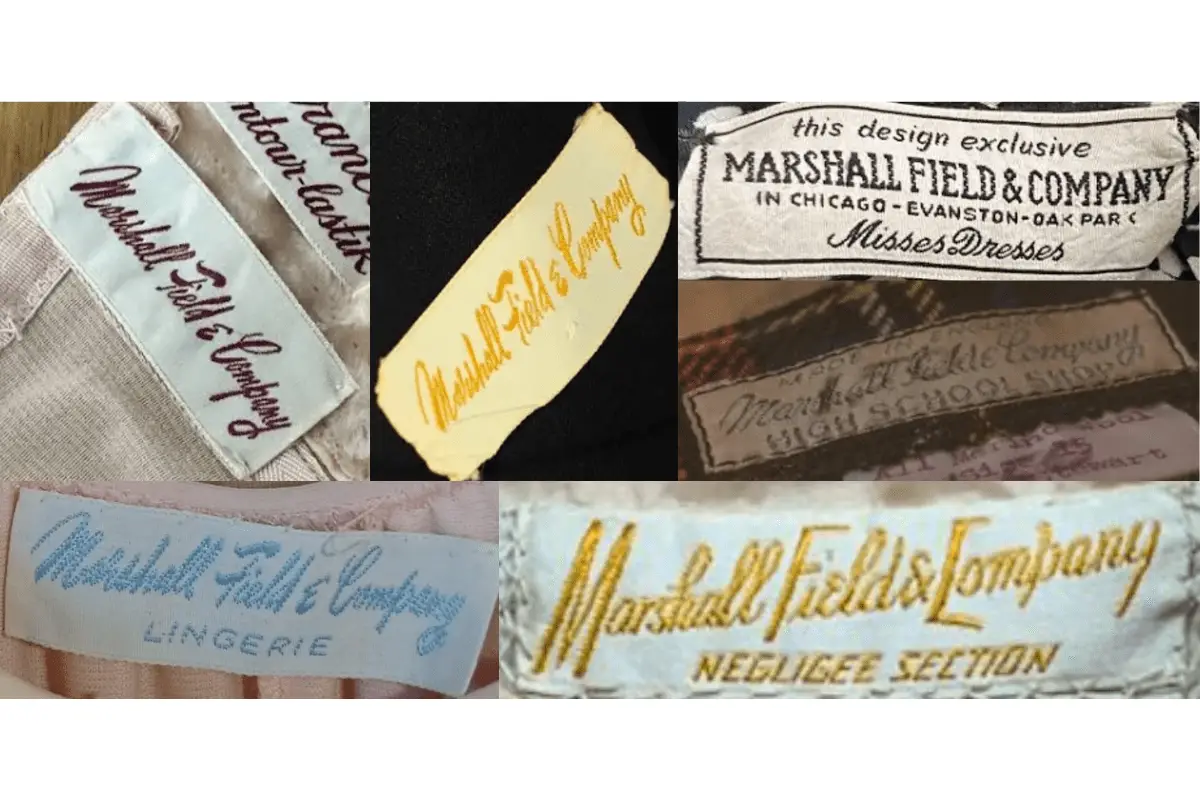
1940s Marshall Field’s tags
1950s vintage Marshall Field’s tags
- Tags still maintained a focus on elegant, cursive lettering.
- Tags often included additional descriptors like “Lingerie” or “Negligee Section.”
- Color schemes were more varied, with tags in shades of pastel blues, pinks, and yellows.
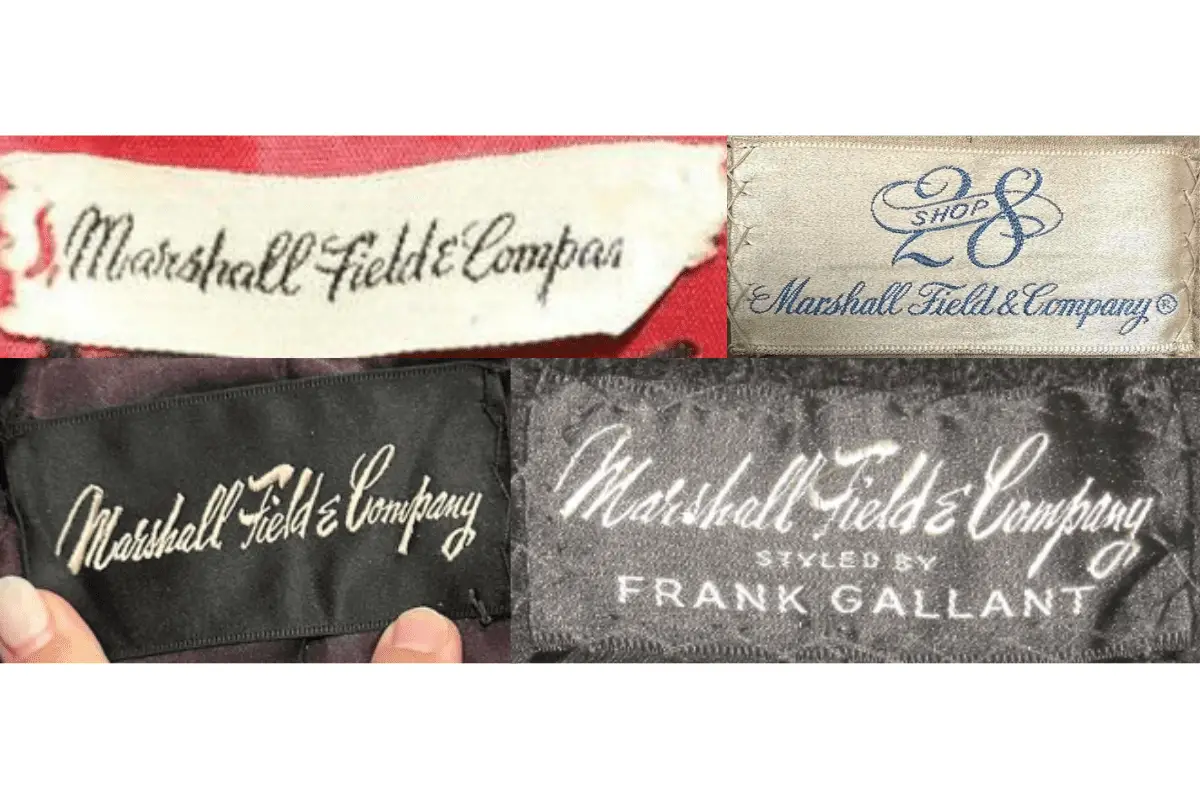
1950s Marshall Field’s tags
1960s vintage Marshall Field’s tags
- Tags began to include more specific collection names like “High School Shop.”
- Continued use of cursive lettering, with some tags featuring exclusive design labels.
- Tags were often small and discreet, focusing on subtle branding.
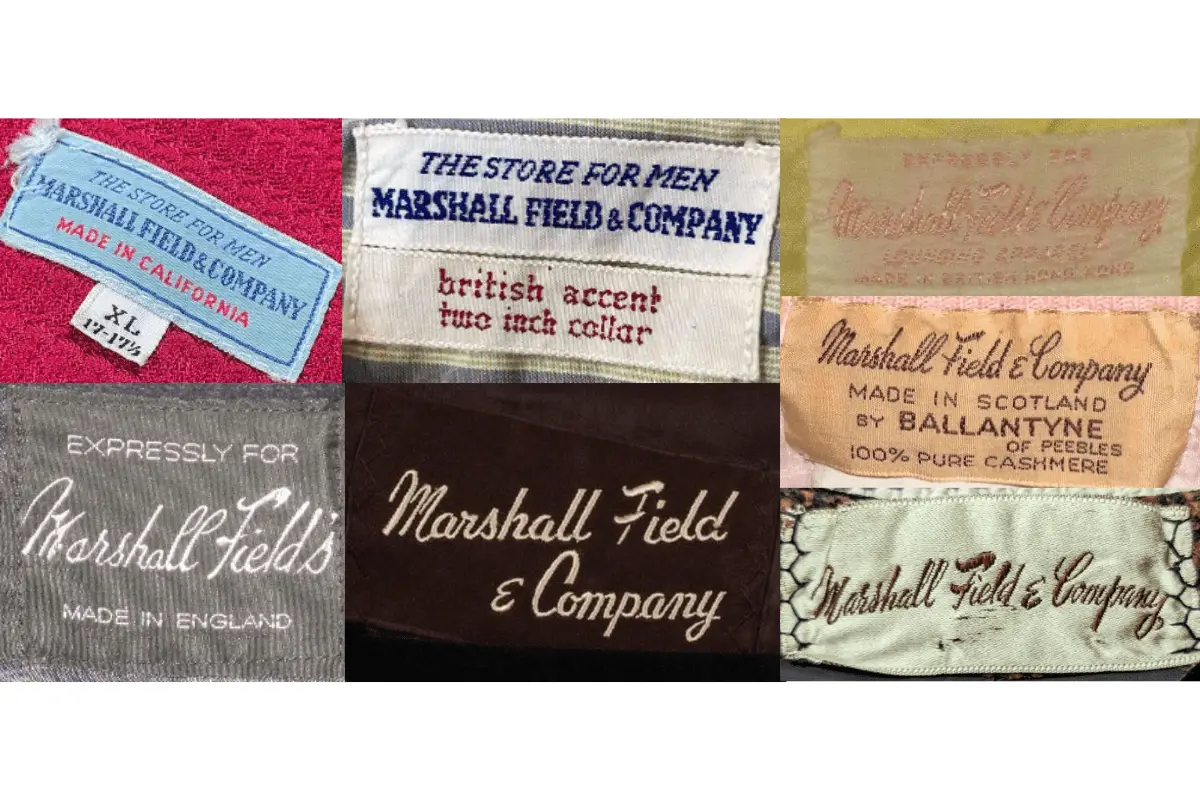
1960s Marshall Field’s tags
1970s vintage Marshall Field’s tags
- Introduction of tags specifying different store locations, such as “Store for Men.”
- Greater variety in tag design, with some featuring block letters and others in cursive.
- Tags often included additional manufacturing details like “Made in Italy” or “Germany.”
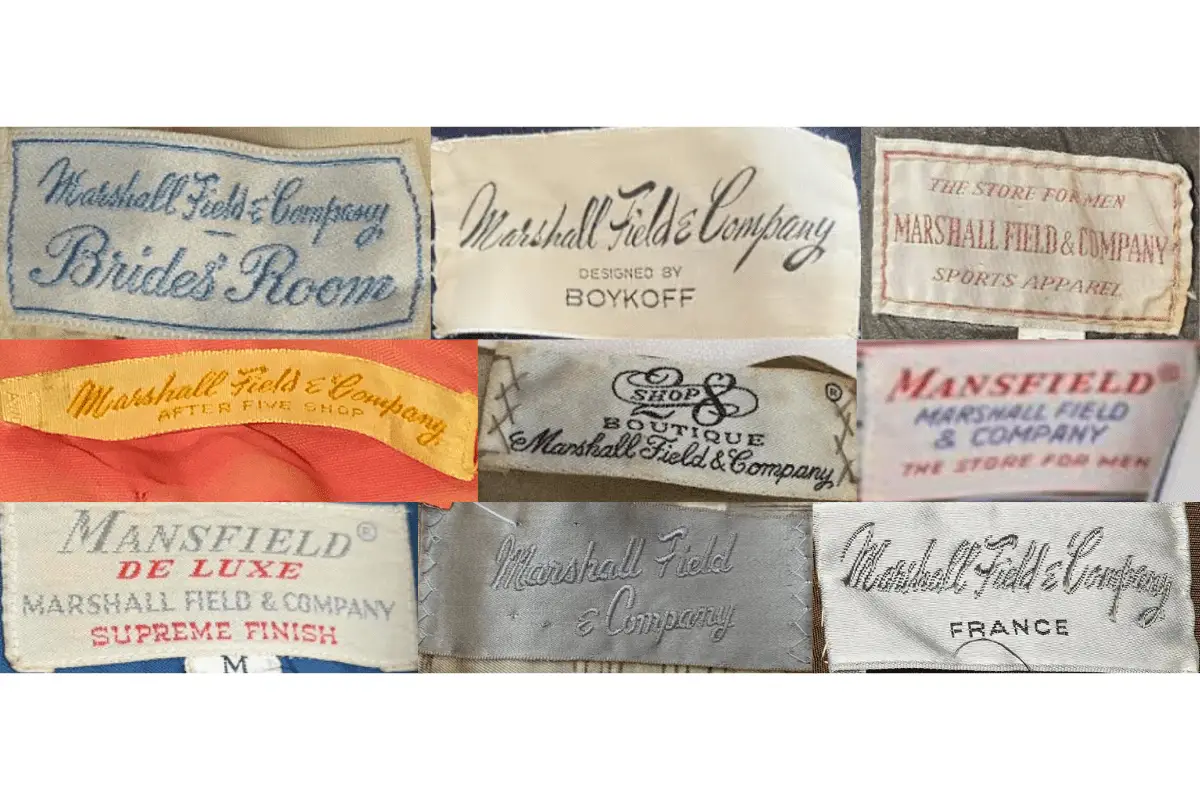
1970s Marshall Field’s tags
1980s vintage Marshall Field’s tags
- Tags prominently featured brand collections like “The Country Shop” and “New Traditions.”
- Tags often used darker, more formal colors like deep greens and blues.
- Some tags incorporated modern fonts alongside traditional cursive for a more contemporary look.
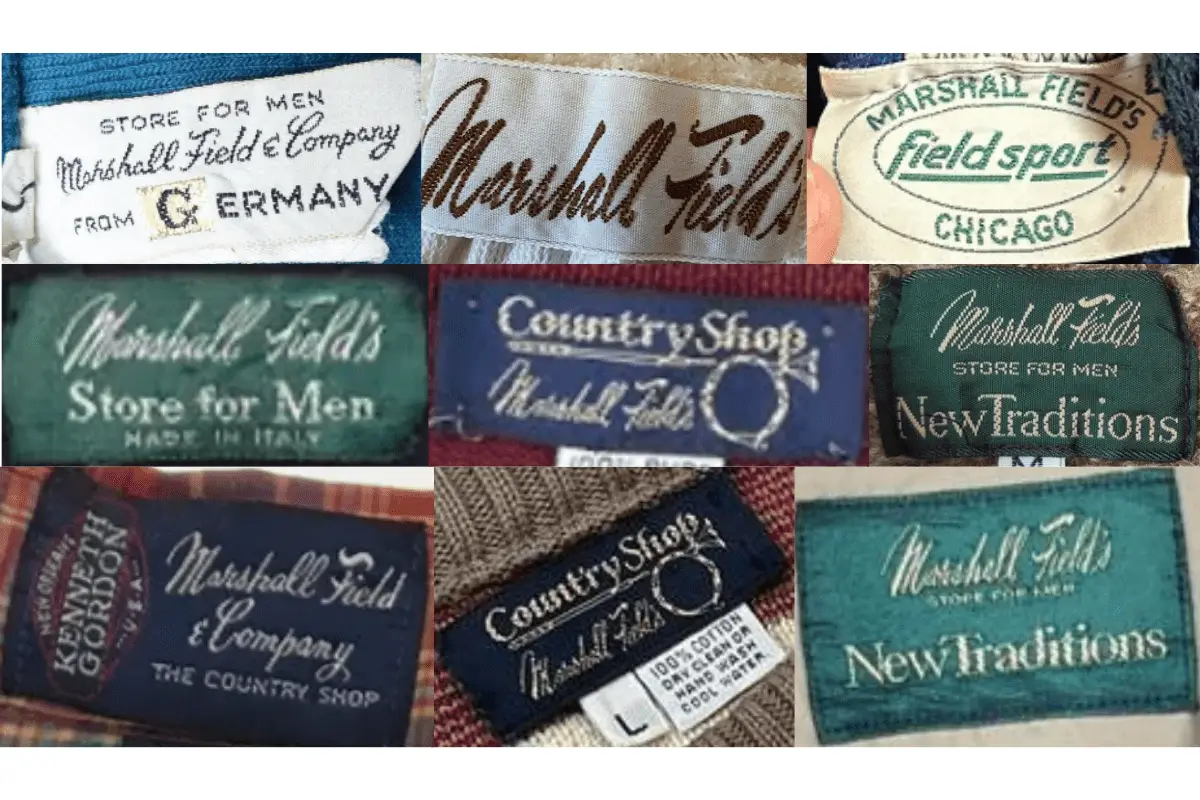
1980s Marshall Field’s tags
1990s vintage Marshall Field’s tags
- Tags continued to focus on specific product lines like “New Traditions” and “Fieldsport.”
- Tags became more varied in design, with some featuring minimalistic styles while others remained traditional.
- Use of fabric labels that were softer to the touch, reflecting a shift in manufacturing techniques.

1990s Marshall Field’s tags
2000s vintage Marshall Field’s tags
- Tags often reflected the final years of Marshall Field’s before its rebranding, featuring sleek, modern designs.
- Introduction of simpler, more streamlined tags with less text.
- Focus on the “Marshall Field’s” name, sometimes dropping the “& Company” from the tags.

2000s Marshall Field’s tags




I don’t think the title of your article matches the content lol. Just kidding, mainly because I had some doubts after reading the article.
Thank you for your sharing. I am worried that I lack creative ideas. It is your article that makes me full of hope. Thank you. But, I have a question, can you help me?
Can you be more specific about the content of your article? After reading it, I still have some doubts. Hope you can help me.